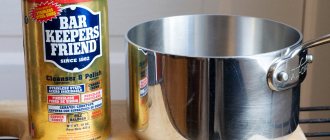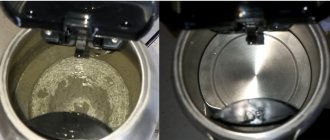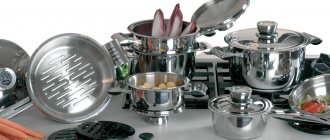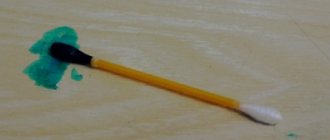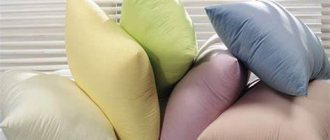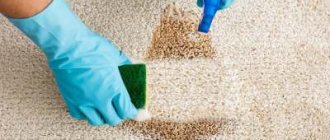A stainless steel sink needs to be properly cared for. Before purchasing a sink made from this material, you should consider whether it can be properly cared for.
Stainless steel is a strong, wear-resistant and resilient material. It is resistant to scratches, stains and other consequences of regular use. However, over time, the sink becomes covered with dark plaque, rust or lime deposits around the silicone seal and faucet.
It is important to know how to clean stainless steel sinks. After all, it’s more pleasant to wash dishes in such a sink.
Anti-blackness remedies
Blackness on stainless steel appears after 2 years. Even with proper care, the surface of the sink darkens and the shine disappears.
To care for the sink, use homemade compounds or household chemicals. You can use several products in combination to get the best effect.
How to clean a sink:
- Vinegar is an excellent cleaning agent. The universal composition saves from blackness, disinfects and whitens well. Directions for use: place a spray bottle on the bottle, spray over the surface, leave for 10 minutes. Rinse with water. Open the windows and ventilate the room.
- Starch and soda are used according to the same principle. A kitchen sponge is moistened with water and starch or soda is added. The oxidized area is cleaned with the hard side. All that remains is to wash the sink to remove any remaining product.
- Bleach works well to remove black stains on a stainless sink, but can leave white marks. Dilute with water, treat the sink, rinse with water. Clean carefully, making sure that the treated areas do not become lighter than the rest of the structure.
- Rub the problem areas with tooth powder.
Blackness is an oxidation process formed due to the negative effects of oxidizing agents. The sooner you start removing dark spots, the better they will come out.
Unfortunately, it is impossible to prevent their occurrence. It remains to use special means from time to time.
Causes of pollution
Stainless steel is resistant to environmental influences, which is due to the chromium content in the material. This element creates a protective layer that protects the surface from corrosion, rust, and blackness. However, improper maintenance results in significant accumulation of dust, dirt and grease. They destroy the protective properties, make stainless steel vulnerable and reduce its wear resistance. Rust, soot, and deposits appear on the surface, and the characteristic metallic sheen of the material disappears. As a result of such contamination, the device or item becomes unsuitable for further use.
As a result of use, stainless steel appliances and utensils darken and become covered with plaque and grease. You can correct the situation at home using improvised means.
To extend the life of stainless steel products, follow the rules for care and cleaning:
- Thoroughly clean off fat and food residues after each cooking;
- During cooking, make sure that the food does not burn to the bottom;
- do not use abrasive compounds or hard tools - they will leave scratches and damage the top protective layer;
- wipe dishes, utensils and surfaces after use to prevent oxidation and avoid streaks and deposits;
- Polish the metal periodically using baby oil or olive oil.
Before storing stainless steel cookware, dry it thoroughly with a soft towel. This will prevent the formation of white plaque and streaks.
Limescale remover
Constant use of the sink requires daily maintenance. Regular contact with water leads to the formation of plaque and stains.
Limescale deposits are not deep and can be easily removed with home remedies. How to clean a sink from plaque:
- Dilute vinegar with water in a 1:1 ratio. The sink will glow like new after using this solution.
- Use a special liquid to remove limescale. For example, Ravak. Stainless steel is treated with the liquid and left to act for 10 minutes. Remove residues with plenty of water.
- Citric acid will clean your kitchen sink. Close the sink and fill with warm water. Dilute a packet of citric acid and stir until all the grains dissolve. Leave to act for 1-2 hours. Rub the walls with the hard side of the sponge, drain the waste liquid, and rinse the walls of the sink. Do not make a strong solution of citric acid; dark spots will appear on the sink.
- Distribute baking soda evenly. Rub thoroughly, rinse and repeat.
- Use Astonish paste to clean pots and ovens. This is a soft abrasive and will not damage the surface. Apply to the sink, rub well with a sponge, and rinse.
- Apply oxalic acid in powder form. Dilute the powder with water. Treat the water stone with gruel. After 15 minutes, wash off the residue.
- Dry mustard gives a good effect. Cover problem areas with powder, wash thoroughly with a sponge, and rinse off the residue with water. Mustard cleans the pipeline well if there is an unpleasant odor. Not suitable for plastic pipes.
The only methods to prevent limescale deposits are to check the taps for leaks and wipe the sink dry after use. Avoid constant presence of water in the sink.
Add shine
The matte film is effectively removed:
- Vinegar 9%. It is applied to the surface of the sink, previously cleaned of stains, and washed off after 20-30 minutes with running water. You can also line the sink bowl with a cloth soaked in vinegar.
- Lemon juice. To make the sink shine, it is treated with a solution (1 tablespoon per 200 ml of water) or pure juice applied to a cloth.
- Ammonia. It is used only in the form of a weak warm solution (5 drops per 1 liter of water). After treatment, it is necessary to rinse the sink with plenty of water.
When working with aggressive substances (vinegar, ammonia and GOI paste), you must wear rubber gloves and open the window.
Removing dirt and greasy deposits
To remove greasy deposits, use regular dishwashing detergent. Laundry soap will do.
A cleaning agent made from soda and office glue will help clean the sink. How to clean a stainless steel sink:
- Boil 5 liters of water, add 100 g. soda and 100 ml of transparent stationery glue.
- Wait for dissolution. Close the sink and pour the prepared solution into it.
- When the mixture has cooled down, drain it.
- All dirt will come off. All you have to do is wash the sink with clean water.
This method is used to clean stainless cookware. It is boiled for 20 minutes, left to cool and rinsed with water.
Some tips for using the washer
- Wash dishes immediately, do not accumulate in the sink. This useful habit will help you always keep the sink clean, and it’s much easier to wash the dishes right away rather than after some time when the food remains dry .
- Remove food waste from the bottom of the sink and do not allow it to accumulate. The kitchen is a place where food is prepared, and accumulated and constantly wet food residues quickly cause the spread of unpleasant odors and pathogens. In addition, over time they may cause stains to appear on the work surface.
- After you have washed the dishes, do not forget to wash the sink with the same detergent and wipe away any drops of water - this is simple and will serve as a good preventive measure against contamination.
- Do not ignore the area around the sink and the taps themselves - wipe, do not leave a drop of water - the water evaporates, but the substances dissolved in it remain and can accumulate, forming characteristic mineral deposits.
- Select household chemicals carefully. Make sure it fits stainless steel sinks. Do not leave cleaning agents on stainless steel surfaces for a long time - just turn on hot water and wash everything off.
- Do not run or allow dirt to accumulate. Use baking soda - it's always on hand, safe, and does a good job of removing grease and mineral deposits.
- If you cannot cope with limescale deposits using improvised means, buy special household chemicals to remove contaminants from stainless steel surfaces and follow the instructions.
- Don't forget about yourself! When using strong household chemicals, wear hand seals and protect the skin of your hands.
How to get rid of unpleasant odor
Cleaning a stainless steel sink is not enough to remove the stink. It can be eliminated using special compounds or folk remedies.
How to get rid of the smell:
- Pour salt into the drain hole. Leave for an hour. Rinse with water.
- Pour the required amount of Mole into the drain. To fill with water. Leave the composition to act for 5–10 minutes. Rinse the drain hole well.
- Spray the sink with baking soda and pour it into the drain. Then pour in vinegar, preferably from a spray bottle. Pour into the drain hole too. A reaction will begin, during which foam and hissing will appear. After 10 minutes, pour boiling water into the drain hole and rinse the sink itself with warm water.
- Pour Domestos or Deboshir into the drain. Leave for 2 hours. Rinse the drain with plenty of water. Domestos can be used to clean the sink. Will clean off any dirt.
When purchasing professional chemicals, pay attention to the composition. If the drain in the house is made of plastic pipes, the Israeli product Pothan will do.
Cleaning the sink
Caring for a stainless steel sink is quite simple, but regular cleaning is not a 100% guarantee of getting rid of dirt. Contact with oxidizing agents may cause dark stains on the sink.
Suitable:
- baking soda;
- table vinegar;
- starch.
Some housewives even use regular bleach for these purposes. Use the funds as follows:
- Soda. The substance is poured onto the hard side of the sponge, moistened a little and wiped the problem areas. For hard-to-reach places, you can take an unnecessary toothbrush. Then everything is washed off with water and wiped in the usual way.
- Vinegar. It will help when the stainless steel begins to darken. Soak a sponge in vinegar and wipe the desired areas with it. Wait twenty minutes, then wash off the composition with water and detergent.
- Starch. To do this, use potato starch; a decoction will also work. Simply close the sink drain and pour the solution into it. Wait until the stains have time to disappear and wash the surface.
- Bleach. Apply the substance to a sponge, rub it on the desired area, and rinse with water. Just remember that whiteness can make the area lighter and stand out in appearance - this is the main disadvantage of this method.
Rules of care
Caring for a stainless sink is simple and easy. The main thing is to follow the rules and not use prohibited cleaning methods.
How to care:
- Select cleaning and detergent products carefully. Stainless steel is easily damaged by acids and alkalis. Study the composition more carefully.
- Do not use steel jaws. This is the main enemy. The iron sponge leaves scratches on the surface. Bacteria penetrate into them, and the sink rusts faster (if it is made of poor-quality stainless steel).
- Remains of food remaining on the strainer should be removed immediately.
- Rinse with warm water after each use.
- In the evening, wipe with a dry cloth, preferably after each wash.
- Regular cleaning is important for stainless steel sinks. Wash once a day with detergent. This will prevent the accumulation of grease and dirt that lead to dark spots on the surface.
- Do not allow rusty objects to fall into the bottom of the sink. Nuts, nails or wire wool will cause rust stains.
- Do not use sharp objects to remove dirt. For example, sandpaper, knife, file.
The advantage of a stainless steel sink is that there are no stains of wine, coffee, tea or juice left on the surface.
If you properly care for your stainless sink, install a water filter and do not use prohibited cleaning products, your sink will look attractive for a long time.
Stainless steel is a good, hygienic material, wear-resistant and reliable. A sink made of this material will not warp if hot oil is poured into it and will not change color.
To ensure that the sink does not lose its functional and aesthetic benefits, it must be properly and regularly maintained.
Why choose stainless steel?
How to choose the right sink? In today's market, sinks made of material that does not rust are relevant.
The main advantages when choosing such a stainless steel kitchen item are:
- Low price.
- The service life is quite long.
- Durable, withstands heavy loads.
- Resistant to high temperatures.
- It does not contain harmful metals.
To ensure that your sink always looks like new, you need to keep it clean. Don’t forget to remove all kinds of dirt from it. Every housewife should remember that cleaning the dish sink should be done regularly. Daily contact with water affects the condition of the coating.
How else to clean stainless steel items
- You can also clean stainless steel with a mixture made from soda and mustard powder, and for hard-to-reach places and small parts it is better to use a soft brush.
- There is another method for cleaning stainless steel - potatoes. Cut the raw vegetable in half and wipe the piece onto the dirty surface. After this procedure, the stainless steel will become shiny. You can boil utensils in potato broth. This manipulation will give the objects a good shine.
- Vinegar is also a good way to clean stainless steel; it is used to wipe objects, which are then rinsed in water and wiped.
- When dark spots appear on stainless steel, the same lemon juice will come to your aid. You just need to wipe the stainless steel with a woolen cloth soaked in this juice. This method perfectly removes plaque from the surface.
- Coffee grounds are a good way to clean stainless steel.
Of course, nowadays there are a huge number of cleaning foams, creams, and gels designed specifically for stainless steel, which can also effectively cope with dirt, deposits and stains on electric stoves, sinks and dishes. In addition, cutlery and other utensils can be safely put into the dishwasher using the maximum setting.
Stainless steel products do not require any special care, but sometimes you have to deal with stains that tend to appear on their surface. From this article you will learn how to clean stainless steel at home, what products should be used for this, and much more.
Features of stainless steel
It’s not for nothing that housewives choose stainless steel saucepans, pots, and kettles. Cookware made from high-quality alloy (chrome, nickel, steel) has advantages over products made from other materials.
Corrosion resistance
Chromium, which is part of the alloy, forms a film on the surface that protects the metal from corrosion. The anti-corrosion layer is constantly updated.
During cooking, the material does not interact with moisture, alkalis, or acids. He is not afraid of dishwashing detergents and food acids.
Strength and Durability
The alloy (X18H10) is highly durable. Dishes made from it are not subject to deformation. The steel surface is not afraid of mechanical damage.
Heat resistance
Stainless steel cookware is designed for a wide range of temperatures. It can be safely placed in the freezer or oven.
Environmental friendliness
There is no place for harmful microorganisms on a smooth polished surface. Food cooked in stainless steel containers does not contain harmful impurities, there are no foreign tastes or odors.
Versatility
Stainless steel models are available for gas, induction and electric stoves. The cooking surface of the latter can be of any type:
- burner pancakes;
- Hi-light;
- glass ceramics.
Flawless appearance
Keeping your products clean is easy. They always look impeccable and fit harmoniously into any interior.
Cleaning products for stainless steel dishes
There are many ways to clean stainless surfaces. You can buy a special cleaning composition at a hardware store or use folk remedies.
Special washing and cleaning compounds
Today, consumers are offered a fairly large assortment of household chemicals that can effectively cope with a wide variety of stains on stainless household items. Experts advise choosing the most gentle and safe means.
The main advantages of special washing and cleaning compositions are time saving and efficiency. The disadvantage is that it is expensive.
Traditional methods
Here are instructions on how to quickly and easily clean stainless steel using baking soda:
- Wash the product with hot water.
- Dry with a towel.
- Cover the contaminated areas with baking soda and wait 1.5 - 2 hours. The soda can be slightly moistened.
- Wipe with a dry cloth or sponge. Rinse everything off with water and wipe dry again with a towel.
If soda does not give the desired result, then you can use the heating method. To do this, the dishes that need cleaning need to be filled with water, put on fire and brought to a boil.
After this, the product must be rearranged from the stove and 2 tablespoons of regular table salt added. After complete cooling, the stains will come off easily - just run a sponge over them.
Acrylic bathtubs, sinks and other acrylic products
If you are the proud owner of an acrylic bathtub or other acrylic bathroom fixtures, be careful when trying to clean your plumbing marvel. Acrylic is very sensitive to aggressive chemicals and abrasives. Therefore, we immediately sweep aside any cleaning powders and brushes with hard or metal bristles.
It is better to clean acrylic plumbing fixtures from limescale only with the help of special detergents designed specifically for cleaning acrylic surfaces . It is not advisable to use concentrated alkalis or acids; the surface can be damaged, and abrasive powders will leave scratches.
citric acid to remove limescale . For this:
- Fill the bathtub (or sink) with hot water.
- Dissolve 100 g of citric acid in a small container, for example in a glass jar (so that the powder is completely dissolved and then does not settle to the bottom), pour it into the bath, stir.
- Leave for 2-3 hours.
- We drain the water, wipe with a sponge, rinse with running water and wipe dry.
